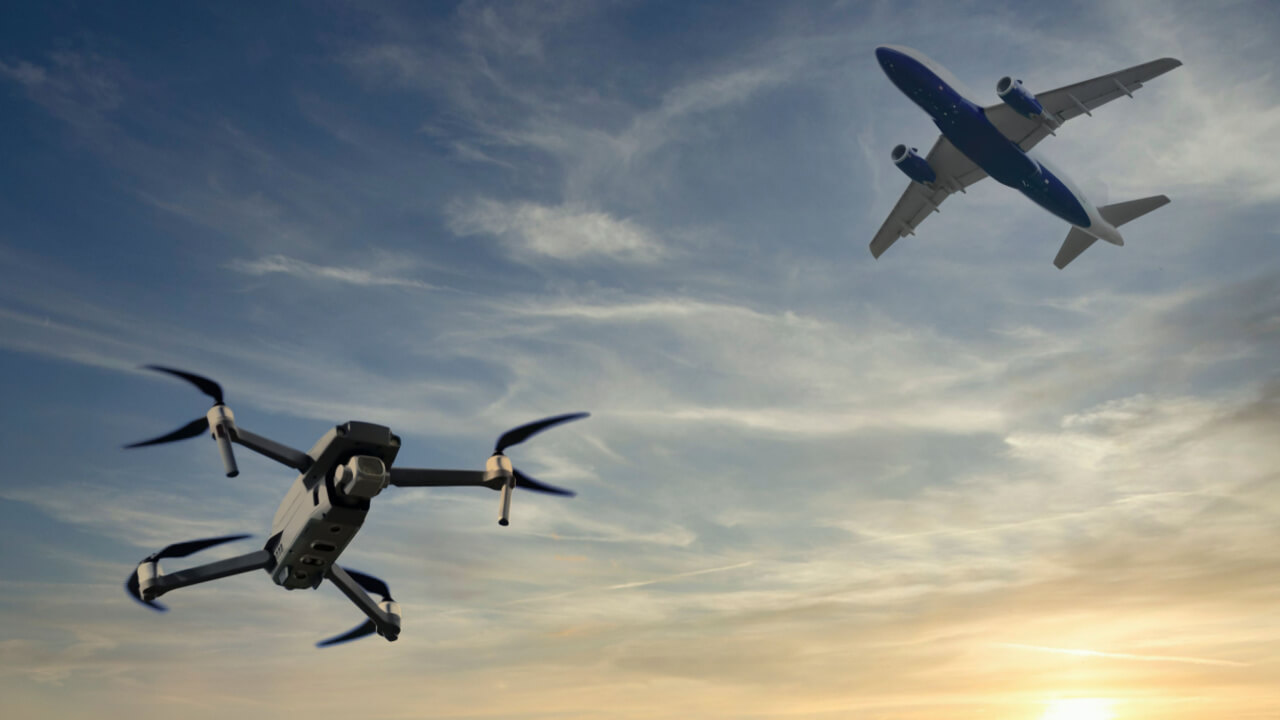By Tom Owens
The following material is provided for informational purposes only. Before taking any action that could have legal or other important consequences, speak with a qualified professional who can provide guidance that considers your unique circumstances.
Every so often, a new tool or technique will emerge that dramatically changes the way architects and engineers conduct their businesses. Among recent revolutionary advancements now significantly impacting the design industry is the development of unmanned aerial vehicles (UAVs), also known as unmanned aerial systems (UASs) or, more commonly, drones.
More and more, drones are becoming an essential tool for A/E firms, enabling them to perform their duties more effectively and more safely. Some design professionals, such as surveyors, now rely on drones to complete many of their essential tasks. Others might use drones only during narrow stages of their projects — conducting a flyover of a building at substantial project completion, for example.
Those who use drones for multiple purposes may want to purchase their own drones and hire or train drone pilots. Other design firms may prefer to contract the drone activities through a subcontractor or other third-party pilot. Regardless, design firms must understand the many rules and regulations that govern the legal and safe use of these UAVs, as well as the liabilities they may incur for not following these rules of the road.
The FAA’s Rules of the Road
The Federal Aviation Administration (FAA) released its Small Unmanned Aircraft Rules, (officially known as Part 107 of the Federal Aviation Regulations), effective August 29, 2016. Design firms using drones in their course of business — whether they purchase and fly their own unmanned aircraft, or hire the services of third-party pilots — face liabilities should these FAA regulations be violated or damages occur.
Drone-related liabilities extend from personal injuries and property damage caused by the drone in flight to losses incurred due to project errors and omissions related to the use or misuse of drone-collected data. For example, if a third party was hit by a drone in flight due to pilot error, the company would likely face liability for physical damages and/or personal injuries suffered. If the design consultant made a design error due to faulty data collected by the drone, a professional liability would likely be incurred. That’s why it’s important to know the operational rules and ensure you have appropriate safeguards, including proper insurance, to cover any losses and liabilities.
The Basics of FAA Regulations
Part 107 of the Federal Aviation Regulations is available in full on the FAA Website: https://www.faa.gov/uas. Here are the highlights of the regulations that were put into effect back in 2016:
- You must register all small unmanned aircraft with the FAA.
- The total weight of the small unmanned aircraft, including cameras or other add-ons and payloads, must be kept below 55 pounds (25 kilograms). Aircraft weighing more than 55 pounds are governed by separate, more complex rules.
- Drones can carry external loads as long as they are securely attached and do not affect the flight characteristics or hamper the control of the UAS.
However, carrying hazardous materials on an unmanned aircraft is prohibited.
- When in flight, small drones must remain in the visual line of sight of the pilot in command or any other person controlling the flight. The unmanned aircraft must also remain close enough to the pilot/controller that he or she can observe the aircraft without the use of binoculars, telescopes or other visual aids other than corrective eyeglasses or contact lenses.
- Small drones cannot fly under a covered structure or inside a covered stationary vehicle.
- Drones must keep their distance from and yield the right of way to any manned aircraft.
- The maximum ground speed of unmanned aircraft cannot exceed 100 miles per hour (87 knots).
- The maximum altitude of the aircraft must not exceed 400 feet above ground level. Exception: when the unmanned aircraft remains within 400 feet of a structure.
- Minimum weather visibility for the drone pilot or control station is three miles.
- No individual can command more than one unmanned aircraft at a time.
- No individual can command an unmanned aircraft from another moving aircraft.
- No individual can command an unmanned aircraft from a moving ground vehicle except in sparsely populated areas.
- Careless or reckless operations are prohibited.
- No person with a known physical or mental condition that could cause unsafe operation of a small unmanned aircraft can operate the vehicle.
- The pilot is required to inspect the unmanned aircraft prior to each operation.
- The remote pilot in command must 1) hold a remote pilot airman certificate with a small unmanned aircraft rating or 2) be under the direct supervision of someone who holds such a certificate.
- To earn a remote pilot certificate, an individual must be at least 16 years old and vetted by the Transportation Security Administration. He or she must also be able to demonstrate aeronautical knowledge by either 1) passing an aeronautical knowledge test given at an FAA-approved testing center or 2) holding a Part 61 pilot certificate and completing both a flight review (within the past 24 months) and an online FAA unmanned aircraft training course.
Once licensed, a remote pilot in command must:
- Make the small unmanned aircraft and related documentation available for inspection and testing upon request by the FAA.
- Report to the FAA within 10 days any accident that results in serious injury, unconsciousness or property damage of $500 or more.
- Conduct pre-flight inspections of the aircraft and control system to ensure they are in good condition for safe operation.
- Ensure the aircraft continues to be properly registered as required by the FAA.
The Evolution of Drone Rules
Part 107 of the Federal Aviation Regulations remains largely intact since its adoption in 2016. However, there have been changes in drone regulations over the past few years. And as drone technology continues to improve and flights become more common, further relaxation of requirements can be expected.
For instance, under the Operation of Unmanned Aircraft Systems Over People rule enacted in 2021, drones can, under certain circumstances, fly routine operations over people and moving vehicles not involved in the drone flights. Previously, pilots had to obtain an FAA waiver to fly drones over people not involved in the operations.
Note that drones flying over people cannot have exposed rotor parts that could cause lacerations should an accident occur. Also, drones cannot maintain sustained flight over any one person who is not part of the drone operations. Privacy issues jump to the forefront when flying drones over crowds or targeted individuals while collecting photos or other data.
Under Part 107, drones could only fly during local daylight hours (30 minutes before official sunrise to 30 minutes after official sunset) or during twilight when using approved anti-collision lighting. Now, drone pilots can fly their small unmanned aircraft at night. However. two conditions apply:
1) The remote pilot must complete an updated knowledge test or online recurrent training that includes an operation-at-night section.
2) The drone must have approved anti-collision lighting that is visible for three miles.
Note that these changes in regulations are not considered blanket approvals and some restrictions regarding flying over crowds or at night still apply. That’s why it’s important to read and follow the current FAA regulations, available online at faa.gov/uas.
Managing Drone Risks
Many design firms that start using drones to improve and broaden their design services begin by hiring third-party pilots with extensive knowledge of unmanned vehicles. Then, as experience is gained, the firm may hire its own pilot and purchase or lease its own drones.
Regardless, check with your attorney regarding compliance with FAA regulations. Together, determine if there are any state or local restrictions or requirements on the commercial use of small unmanned aircraft.
Your primary tool for managing risks is to ensure your pilots and any others directing the use of drones at your firm are well trained, knowledgeable, experienced and conscientious regarding the safety and privacy of others. Inform all relevant parties of your upcoming drone operations. Develop a privacy policy that specifies the reasons for the aerial operations; what data you are collecting; and how that data will be used, retained, and disseminated. Where possible, get a consent form from all parties directly affected by the drone flights. Also, set policies for securing, limiting access to and deleting collected data.
The unmanned aircraft should be well maintained and carefully examined and tested before each flight. You should maintain an operating manual, keep detailed flight logs for all aerial activities and promptly report any accidents, injuries and damages to the FAA and your insurance carriers.
Proper insurance coverage is a critical piece of your risk management practices. In the past, most commercial general liability (CGL) policies specifically excluded coverage for any liability arising out of the ownership, maintenance and use of aircraft. With the rapid growth of the commercial use of drones, however, many insurers are now willing to add such coverage through a CGL endorsement. Such endorsements can cover property damage and bodily injury caused by the use of the aircraft as well as damage to or loss of the drone, its ground controls or its loads. Most CGL insurers will also offer personal injury coverage, including coverage for invasion of privacy, as an option.
In today’s insurance marketplace your may be able to find dedicated commercial drone insurance policies. These are annual policies that provide legal liability coverage for property damage and bodily injury caused by your operation of a drone. Policies also typically cover the cost of your legal defense should you be sued as a result of your drone operations. This is a rapidly evolving coverage in the insurance industry, so have your agent or broker thoroughly investigate your options.
If you hire a subconsultant or other outside vendor to operate small unmanned aircraft on your behalf, ask to be named as an additional insured on their CGL or drone policy, and ensure they have adequate coverage limits. (typically $1 million to $5 million of coverage). Or, you might be able to purchase your own non-owned aircraft coverage, either by endorsement to your CGL policy or as a standalone policy.
Finally, the use of drones can also result in professional liability (PL) for your firm, which is likely not covered by your CGL policy. The failure to perform up to the current standard of care regarding the use of drones, as well as design errors or omissions made due to the misapplication of information gathered during the use of drones, can result in professional liabilities. Check with us regarding how your current PL policy covers the use of small unmanned aircraft. A PL policy endorsement may be needed to provide you with proper coverage.
Can We Be of Assistance?
We may be able to help you by providing referrals to consultants, and by providing guidance relative to insurance issues, and even to certain preventives, from construction observation through the development and application of sound human resources management policies and procedures. Please call on us for assistance. We’re a member of the Professional Liability Agents Network (PLAN). We’re here to help.

